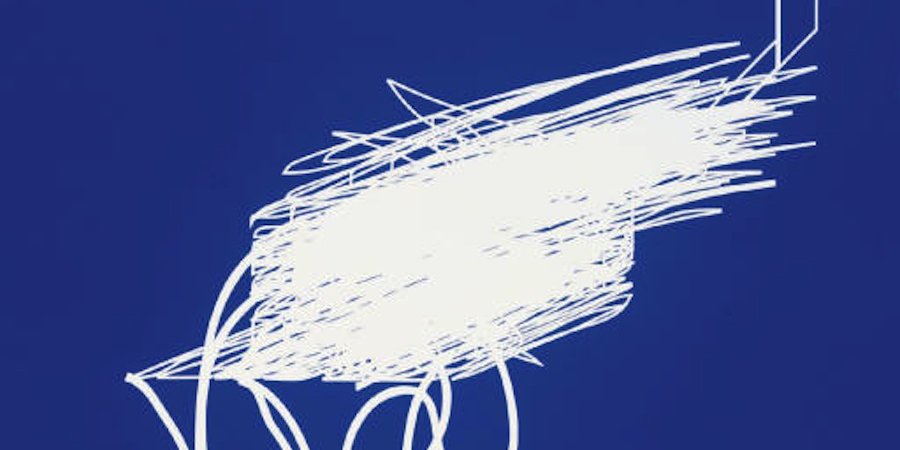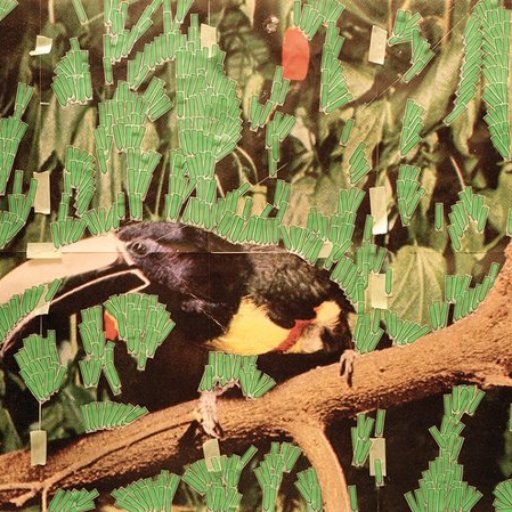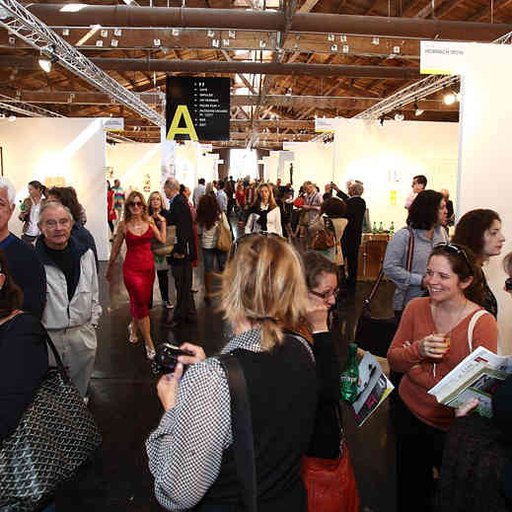Last week's spree of auctions in New York City was another record-setting event in the history of the art market, surprising absolutely no one. Christie's pulled in nearly $1 billion, the vast bulk of it owing to an evening sale that netted $853 million, while Sotheby's garnered $435 million—including $36 million from a Jasper JohnsFlag, a new benchmark for the legendary figure—and Phillips scratched out about $60 million, all told. But while the peak of the market told the expected story of marquee works by famous names winning ever-heightening prices—a product of third-party guarantees, deal-brokering, and basic inertia that all but makes the top lots a foregone conclusion before anyone enters the salesroom—the real action was taking place below the money-green canopy, among the less established, less predictable critters in the day sales on the market's floor.
Here, in contrast to the epic numbers of the evening sales, there seemed to be signs of sobriety, particularly when it comes to some of the younger artists that have been catnip for speculators during the last few market cycles. If the spring season reached fever-pitch, with collectors in headlong pursuit of young artists whose worth was generated mainly by rising prices and insider word-of-mouth rather than institutional or critical support, this season's buyers seemed to be looking for longer-term investments that they could cuddle up to over the long winter.
It means something, for instance, that over a quarter of the Phillips day sale, a reliable casino for betting on new art, failed to sell at all, with four lots pulled entirely; at the Sotheby's day sale, meanwhile, contemporary classics (like Judd boxes, Albers squares, Kusama nets) fared well, while deals could be found on touted emerging artists like Ryan Sullivan, whose abstract painting went for $62,500 against an $80,000 low estimate. But if the vogue for the endlessly inventive ways that young artists can smear chromatic dirt on rectangles may be losing a bit of steam, there were of course exceptions, with passions flaring up in pursuit of the next new thing. Here's an analysis of the week's winners and not-so-winners.
WINNERS
It's a simple formula: if an artist reliably doubles their estimates they can be said to have market bounce; triple or quadruple your estimates... and collectors rubberneck. By that metric, the stars of last week were Jeff Elrod, Tony Lewis, Petra Cortright, Dan Rees, and Christian Rosa—and, guess what, they're all abstract painters!
Elrod, who has appeared at auction nine times this year since one of his black-and-white paintings saw a more than tenfold jump over its $15,000 low estimate, notched a new record when another black-and-white composition of UV ink on canvas fetched $305,000 against a $50,000-70,000 estimate at Sotheby's; painted this year, it was sold to benefit the Elton John AIDS Foundation. Another blue-and-white piece in the same sale tripled its estimate to notch $161,000.
An artist who similarly specializes in black-and-white abstractions, using graphite to write text in computer fonts on sheets of taped-together paper, Lewis made his auction debut in New York's May sales with a piece that won $93,750 against an $8,000-12,000 estimate. He repeated that feat in the Phillips day sale last week, taking in $81,250 on a heightened $20,000-30,000 estimate. Lewis, whose heat stems in large part from the bona fides he earned as a participant in this year's Whitney Biennial, is a comer.
Petra Cortright is a Los Angeles-based Post-Internet starlet who swims with that city's speculative sharks while simultaneously deriving credibility from her authentically Web-to-table videos and paintings-on-aluminum, which she puts together on Photoshop and has printed. After having her first auction outing at Phillips London over the summer with one of her less-compelling Web prints on silk—an updating of the term "silk screen" for the screen age, perhaps—two of her more-coveted aluminum paintings quadrupled their low estimates at Sotheby's and Phillips, earning about $40,000 apiece.
Dan Rees is not Dan Colen, whose market has hit a lull, though he also makes colorful paintings on canvas using unexpected materials, in his case often Play-Doh or Artex, a type of surfacing used in interior design. Rees has had 22 appearances at auction over the past two years, and he saw a record at Sotheby's last week when an Artext painting from 2012 won $233,000 against a $65,000-75,000 estimate, while a Play-Doh piece from 2011 tripled its estimate at Phillips for $93,750.
By now everyone's heard of Christian Rosa, arguably the year's breakout market star if only on the basis of his top-heavy buzz-to-CV ratio—much of that resulting from the fact that his first painting to appear at auction, at Phillips London over the summer, o'er leapt its $17,000 low estimate by tenfold, even though few outside of L.A. have seen his work in person. Somehow since then he's made six more auction appearances, and he set a new record at Christie's with a Twombly-in-space abstraction that made $209,000 on a $60,000-80,000 estimate, while higher-estimated similar piece in the Phillips evening sale did well at $161,000 against $80,000-120,000. Another similar piece in the day sale sputtered, relatively, at $87,500 against $60,000-80,000.
Bonus: One unusual and propitious debut was Justin Matherly, the excellent sculptor who recently started showing his concrete-and-medical-equipment pieces with Paula Cooper, and whose first auction appearance earned $32,000, four times its estimate—which is especially impressive given how spottily "unmonumental"-style sculpture fares at these sales.
STARS IN THE MAKING?
It's not hard to tell when the auction houses are trying to create a market for a young artist—after all, they're not being subtle when they suddenly put someone in sale after sale. Both Phillips and Christie's are pumping this fall for Wyatt Kahn, who makes jagged monochrome shaped canvas pieces, debuting his work in their London sales in October and now trying him out in New York. Already carrying a high estimate, he picked up his second-highest price in the Phillips evening sale when a white composition from 2012 made $185,000 against $100,000-150,000, while the Christie's afternoon sale saw him double the low estimate to fetch $100,000 on a similar piece from the same year.
Ethan Cook, who hand-weaves patches of cloth canvas that he sews into his abstract geometrical "paintings," is another artist that those two houses are trying to build, and although he hasn't repeated the sixfold estimate-thrashing he achieved at Phillips London over the summer, he's doing respectably well, roughly doubling estimates. Phillips, meanwhile, is throwing itself behind the young monochromist Michael Staniak after he multiplied a low estimate by seven times at their London location over the summer, and, paired with low estimates, he's looking good. The French painter Jean-Baptiste Bernadet is another Phillips fave—maybe they're intuiting a revival of Tachisme, since his abstractions are throwbacks to the swaggering Gallic prettiness of Jean-Paul Riopelle, among others—and they've debuted him in four sales this fall. He doubled his estimate in New York, bu so far he fares best in Europe.
Meanwhile, Nick Darmstaedter of the Still House Group (the new Brooklyn Barbizon?) who uses refrigerator magnets and other unusual found materials to make charming colorful "paintings," entered the auction sphere with two London sales this fall, and he had three lots in New York last week find mixes success—two falling within estimates, one magnet piece doubling—but nowhere near his near-tenfold coup at Philips London that brought in $129,500. Finally, Phillips is betting that if you haven't heard of Aaron Garber-Maikovska, another L.A.-based doodler who makes jazzy vertical abstractions that look torn from the Sunday funnies, you will. He's been reliably tripling his bunny-slope estimates in his first two showing with them, fetching around $35,000 a pop.
NOT-SO-WINNERS
First, let's get it out of the way that Oscar Murillo, Alex Israel, and Jacob Kassay are doing fine. In fact, at a time when Murillo seems intent on bringing attention away from the graffitied abstractions that made him famous, he saw his third-highest price—$377,000—achieved at the Phillips day sale, $245,000 for the witty Dark Americano (scrawled with "milk," as for the coffee) in the evening sale, and a more modest $137,000 in the Christie's day sale. (Another painting, in the Phillips day sale, was his second ever to fail to sell entirely.) Israel performed roughly within estimates, nothing crazy, and Jacob Kassay's mirror paintings still push bidding slightly above estimate.
We know some collectors are willing to put a painting they love up at auction because of a force majeure incident—death, divorce, or debt, traditionally—but has some strange ebola-like affliction visited itself upon the collectors of David Ostrowski? Since his auction debut in January, a staggering 31 pieces by the Cologne-based painter with the barely there white-and-blue aesthetic have gone under the hammer, and while estimates have crept up to established-artist levels, tallies have begun to dip noticeably where now he's consistently falling within estimate and is lucky if he reaches half his July high-water-mark of $292,600. In the Phillips day sale, for instance, an F (Gee Vaucher) (2012) went for $93,750, versus a for all intents and purposes identical F (Gee Vaucher) (2012) painting that made $120,000 in London a month ago, though a different F (It's not easy being a Supermodel) edged up to $118,750 in the Phillips evening sale. When too much art is made, and too many collectors are too eager to cash in too quickly, it's too bad.
The polar vortex seems to have descended on Israel Lund's market as well, probably owing to his rash of 17 very similar-looking auction appearances since his first sale bow in the spring. He hasn't been able to break the $100,000 barrier for a single piece in his past 10 outings. Last week, of his four showings, only one managed to go slightly above estimate, for $47,500—a vast shift from the spring, when Bloomberg's Katya Kazakina noted that his works were hammering at a 1,567 percent increase over the $7,500 they were priced at in his previous gallery show.
Parker Ito, auctioned 23 times this year, has not seen his market catch fire this fall in the way it did earlier this year, where his debut sextupled its estimate to mint $93,700. All four pieces last week stayed within estimates, the highest fetching $40,000 and the lowest going for $10,000 below it's bottom estimate. Lucien Smith may wish he were Parker Ito right about now. A year since he became a star when his art-school painting made $389,000 as the first lot in the Phillips evening sale—his auction debut—another one of his pieces, this time a "rain" painting, failed to find any takers in that same sale, along with two of his sculptural efforts in the Sotheby's day sale; two other paintings sold within estimates, both under $100,000.
Meanwhile, be wary of seeing Nathan Hylden or David Noonen as investments—half of the times they've been brought to auction this year they've been heard crickets.
RECORDS
– The late American Abstract Expressionist painter Sam Francis is undeniably having a market moment: he earned a new auction record of $4.9 million at the Christie's evening sale, and doubled estimates in each of his six other appearances this week.
– Louise Nevelson, at $989,000
– Fredrick Vaerslev, $317,000, for one of his stripe painting (though one of his picnic-table wall pieces was bought in for the second time in a row)
– Danh Vo, $629,000, for one of his Statue of Liberty casts
– Larry Poons, with a colossal $1.2 million against $150,000-200,000, nine times his previous record (Poons, incidentally, played in the Druds)
– French sculptor Claude Lalanne was the week's surprise winner when his friendly bronze garden bunny tickled some magnate into paying $2 million for it, 10 times the low estimate.
– Tauba Auerbach, $2.3 million
– Rashid Johnson, $197,000
– Keltie Ferris, $106,250
– A triptych by Jack Whitten, an inspiration to young abstract artists like Angel Otero, far outstripped his previous record of $8,750 to bring in $118,750, quadruple the low estimate.
– Jacqueline Humphries, $81,250 (matching September record at Phillips)
– Amy Sillman's prices finally broke through to match her stature when a painting quadrupled her previous record to fetch $125,000 (est. $20,000-30,000)
– Seth Price, $785,000 for a bomber-jacket piece that was the first lot in the Christie's evening sale, knocking off the cover on its $50,000-70,000 estimate.
– Peter Doig, $18 million
– Jonathan Horowitz, $118,750, nearly quintuple the low estimate
– Kerry James Marshall, $1 million
– Elaine Sturtevant, $3.4 million
– Draftsman Dryden Goodwin backed himself into a record when his first drawing to go to auction sold for $625 in the Christie's morning sale… on a $3,000-5,000 estimate.
– Ewerdt Hilgemann, Zero Group-influence sculptor, $75,000
– Greg Bogin, $21,250
– Andrei Sharov, $53,125
– Jiro Takamatsu, $221,000
OTHER NOTABLE AUCTION DEBUTS
– Justin Adian, $52,500 (est. $12,000-18,000)
– Stanley Casselman, they guy who made a fake Richter for Jerry Saltz, $47,500 (est. $25,000-35,000) for a fake Richter
– Jon Rafman, $10,000 (est. $10,000-15,000)
– Hugo McCloud, designer turned painter championed by Vladimir Restoin-Roitfeld, $27,500 (est. $10,000-15,000)
– Valerie Snobeck, $52,500 (est. $20,000-30,000)
– Hyon Gyon, painter influenced by Korean shamanism, $50,000 ($10,000-15,000)
– Zak Prekop, $17,500 ($8,000-12,000)


























